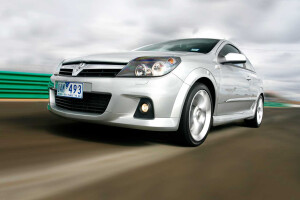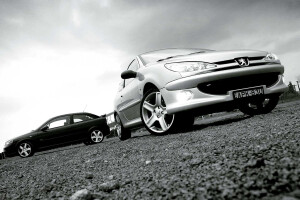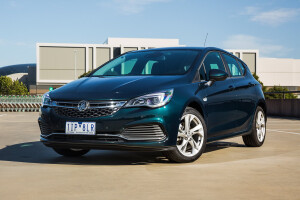Latest Review

2019 Holden Astra Hatchback Review
Everything you need to know about the Astra hatchback, including pricing, updates and features
What stands out?
The Holden Astra hatchback ranks among the most entertaining and satisfying to drive of popular small cars. The German-designed, Polish made import is nicely finished, handles very well, and offers a choice from two strong turbocharged engines and manual and automatic gearboxes. The Astra, which is being discontinued from sale, comes with a five-year warranty, and autonomous emergency braking is available.
What might bug me?
In the more powerful, 1.6-litre, Astras, paying more for fuel. Holden recommends you fill with premium petrol (95 RON), which costs more than regular petrol or E10 (a mixture of petrol and ethanol).
Driving under 80km/h on the space-saver spare tyre until you can fix your full-sized flat.
That Holden parent General Motors has sold German company Opel, which makes the Astra, to French company PSA Group, which owns Peugeot and Citroen. The change of ownership won’t stop Opel making the car, which is popular overseas and was named European Car of the Year when launched there in 2016. You can expect that Holden will continue to sell the Astra over the life of the model, and will maintain a supply of replacement parts.
What body styles are there?
Five-door hatchback, four-door sedan and wagon.
This review covers only the European-built hatchback directly. Click here for a separate review of the Korean-built Astra Sedan.
The Astra drives its front wheels, and it is classed as a small car, lower priced.
What features do all Astra hatchbacks have?
Cruise control with a speed-limiter (which ensures you do not exceed the set speed and so helps you avoid fines). A reversing camera, and rear parking sensors (which help you judge how far the rear bumper is from obstacles).
An MP3 compatible sound system with (outstandingly reliable) DAB+ digital radio reception, Aux and USB inputs, Bluetooth connectivity for audio streaming, voice control, and six speakers.
A colour touchscreen (7.0-inch on the less costly Astras) for controlling cabin functions. Support for Apple CarPlay and Android Auto, which lets you plug in a compatible smartphone and display on the touchscreen some of its apps (including mapping). You can then operate the apps from the touchscreen (or by voice).
Controls on the steering wheel for the cruise control, the audio system, and your phone.
Headlamps that switch on automatically when it’s getting dark.
Aluminium alloy wheels (which look nicer than steel wheels with plastic hubcaps), and a speed-limited space-saver spare wheel.
A Sports Mode button, which allows you to adjust how directly the Astra responds to your use of the steering wheel and accelerator pedal.
Hill-start assist, which makes it easier to take off on an uphill slope (by controlling the brakes automatically). Traction control, which prevents you from spinning a front wheel if you try to accelerate hard where it’s slippery.
Electronic stability control, which can help you control a skidding car. All new cars must have this feature.
Six airbags. (For the placement of airbags, and more on Astra safety systems, please open the Safety section below.)
Every Holden Astra carries a five-year, unlimited-kilometre warranty.
Which engine uses least fuel, and why wouldn't I choose it?
Two engines are available in an Astra, both turbocharged four-cylinder petrols. The more fuel-efficient is the smaller and less powerful 1.4-litre supplied with the least costly Astras, the Astra R and R Plus, which consumes 5.8 litres/100km on the official test (city and country combined).
In real-world driving you can expect to average about 8.5 litres/100km from a 1.4-litre Astra. This is a smooth, strong engine, and very effective in propelling the car effortlessly.
The main reason you might not choose the 1.4 is that you like the idea of having more power than you need. Another is that you want some or all of the features attached to the more expensive Astras, the Astra RS and RS-V, both of which come only with a bigger, 1.6-litre, engine. The 1.6-litre feels more responsive than the 1.4, and develops about 25 per cent more thrust if you ask for all it can give. It too is smooth, and it is unusually strong for a popular small-car engine. It uses about 10 per cent more fuel on the official test.
To a greater extent than in many small cars, fuel economy in an Astra depends on how heavily you depress your right foot. The strength of the 1.6 engine means you have less opportunity to work it hard, and in conditions that encourage you to exploit a car’s performance it may use less fuel than the 1.4. In contrast, if you make use of the strong pull available as soon as you press the accelerator in either Astra, caressing the throttle rather than prodding it, you will be rewarded with much lower fuel use and the 1.4 will be significantly the more thrifty engine.
Expect about 9.0 litres/100km from a 1.6-litre Astra in real-world driving, on average.
The Astra R and RS-V come standard with a six-speed manual transmission, with a six-speed auto (that’s standard on the R+ and RS) an extra-cost option. The auto is a conventional torque-converter type, which offers smooth take-offs around town and satisfyingly swift responses to your demands on the open road.
Auto Astras (only) have a stop-start feature that saves fuel (and emissions) in the city. It turns off the engine automatically when you stop, and starts it again when you take your foot off the brake pedal to drive away – and in the Astra the starting is almost imperceptibly smooth and instant.
What key features do I get if I spend more?
The least costly Astra, the Astra R, comes with the 1.4-litre engine, 17-inch wheels, cloth seats, manual air-conditioning, and the features supplied with all Astras.
For another $2200 or so, you can have an R+ – which is an R with a Driver Assist option pack and automatic transmission as standard. The main thing that buys you is a suite of active safety aids that look out for you in case your attention strays. It comprises a forward collision warning, autonomous emergency braking, and lane-keeping assistance. You also get leather wrap on the steering wheel, and windscreen wipers that operate automatically when it rains. (For more on Astra safety systems, please open the Safety section below.)
Spend more for an Astra RS and you get the R+ additions and the more powerful, 1.6-litre, engine with the automatic transmission. You can unlock an Astra RS and drive away without removing its smart key from your bag or pocket. Front parking sensors augment those at the rear, and Park assist can steer you automatically into a parking spot. The exterior mirrors can be power-folded against the body (to keep them out of harm’s way when parked). Finally, a blind-spot alert warns you if there is a car near your rear corner that might not show in the mirror.
Spending more again for an Astra RS-V brings you more luxury, a sportier look, and the opportunity to add yet more features at extra cost. An RS-V comes with leather on the seats, and dual-zone climate control (which lets driver and passenger choose different ventilation temperatures). There is powered adjustment for lumbar (lower back) support from the front seats, and the seats and steering wheel can be heated. An 8.0-inch touchscreen displays built-in satellite navigation. Taillights use very long-lived LEDs. The wheels grow an inch to 18 inches, and are wrapped in lower profile tyres for marginally sharper steering and a sportier look.
At extra cost, you can equip your Astra RS-V (only) with a Touring pack, comprising a powered sunroof and Adaptive cruise control (which will slow you to the speed of a car ahead until you can overtake). Alternatively, you could spend more on an Innovations pack, which adds Adaptive LED headlamps to the Touring pack’s sunroof and active cruise. The very powerful and long-lived headlamps dip automatically only that part of their high beams that would dazzle other drivers, retaining full illumination to either side. The RS-V comes standard with the manual gearbox, with the auto costing an additional $1000.
Does any upgrade have a down side?
The bigger, 18-inch, tyres on the Astra RS-V may cost more to replace, and will feel a bit bumper to drive on than the taller-profile tyres on other Astras (because their shallower sidewalls leave less air and rubber between you and the road). As well, on coarse-chip road surfaces this wheel and tyre package generates more noise in the Astra’s cabin.
The more expensive Astras require premium petrol.
You can have white or red paint as standard. The other six available colours cost extra.
How comfortable is the Astra?
The Astra is built by German carmaker Opel, which has been producing front-wheel drive small cars since the late 1970s. Its experience shows on many fronts.
Take the packaging. The doors open wide, allowing easy entry to a cabin with more than ample room for four adults – or at a squeeze, five. The seats might seem a little flat to begin with, but in both rows they have a firmness of structure that provides decent support over long distances.
Clearly Opel created the driving position to accommodate tall people, building in a huge amount of adjustment for the steering column and front seats. Further, the backrest angle follows the European norm in allowing very fine adjustment from a wheel rather than relying on pre-set slots and a lever, allowing you to make tiny changes until you are in just the right spot. Small but important details here.
Simple, flowing horizontal themes define the Astra’s contemporary and well-presented dashboard. Easy to figure out and operate, the handsomely designed analogue dials are divided by a handy LCD screen that offers array of useful trip and vehicle-operation details, including a secondary, digital, speedometer. Useful for keeping beneath the limit with speed cameras about.
Build quality also seems to be on the money, even though some of the lower-sited plastics are harder and coarser than you might expect in a German-engineered vehicle put together in Europe. There’s also storage aplenty, backed up by three lidded compartments (finding the third might take a while – it’s below the headlights switch).
Vision is generally good, especially looking forward between the thin pillars and over a low-set dash. Thick back-door posts (C-pillars) and a relatively shallow back window do curtail rear vision. Standard rear sensors and a reverse camera are welcome, but there is nothing like being able to see out for yourself.
The Astra’s sporty chassis tuning means the suspension isn’t quite as soft or supple as it is in many popular small cars (including the Volkswagen Golf, Peugeot 308 and Ford Focus). The ride quality is undermined by firmness in all models, with the larger-wheeled Astra RS-V also suffering from tyre-noise intrusion. Not to deal-breaking levels, but certainly noticeable over some coarse surfaces.
What about safety in a Holden Astra?
Every Astra comes with six airbags: one each ahead of the driver and front passenger; an airbag outside each front occupant at chest level to protect from side impacts; and side-curtain airbags extending past both seat rows at head level.
All Astras also have the mandatory stability control (which is tuned particularly well), seatbelt pre-tensioners for front and rear passengers, a reversing camera, and rear parking sensors. LED daytime running lamps help other drivers see you, and auto-on headlights make you visible more reliably at dusk.
The Astra R Plus, RS and RS-V add autonomous emergency braking as part of a camera-based active safety suite that also brings you a forward collision alert, lane-departure warning and lane-keeping assistance.
The camera scans the road ahead for obstacles, and if it concludes a crash is likely it alerts you audibly and with a head-up visual warning projected onto the windscreen in your line of sight. If you brake but only gently, the Astra will add brake pressure if necessary. If you ignore the warning altogether, at speeds under 60km/h it will apply the brakes automatically with the aim of minimising your impact speed – or avoiding the crash.
The camera also monitors road markings, and triggers an alert if you have begun to drift wide of your lane – perhaps through distraction or fatigue. It can apply a light steering correction, to wake you up and help bring the car back.
The Astra RS and RS-V in addition supply a blind-spot monitor and lane-change alert. Displays on your external mirrors light up on the relevant side when another vehicle is out of view near your rear corner. If you indicate to change lanes to that side, the display will flash.
The Australasian New Car Assessment Program (ANCAP) awarded the Astra R Plus, RS and RS-V a five-star rating for safety, its maximum, in November 2016. (The less costly Astra R has not been rated, but only because it does not come with auto braking and the other active safety features of the more expensive models submitted for testing, and therefore is not strictly equivalent to the tested cars.)
I like driving - will I enjoy this car?
Keen drivers take note: Holden says it tuned the Astra’s engine response, steering and suspension especially to suit Australian buyers’ tastes, at its Lang Lang proving ground just outside Melbourne.
The result certainly shows. Whether it’s a 1.4 or a 1.6, the Astra has that instant off-the-line response that people seem to like, backed up by a ready well of power that the engine seems to supply without effort.
The 1.6-litre Astras feel especially gutsy at high speeds, with ample power in reserve for fast and safe overtaking.
Credit must also go to the six-speed automatic transmission, which shifts gears quickly and readily and has no problem at all keeping the turbo engine on the boil. The auto has a manual mode, activated by flicking the gear lever over to one side. Pushing forward is for upshifts, while pulling back activates a downshift.
The Astra’s steering feels connected and weighty, for solid and surefooted handling, so that you have a sense of commanding the road. Yet the helm is also light enough at slower and parking speeds for easy manoeuvring. Job well done, Holden.
However, while keen drivers may revel in the Astra’s ability to carve through corners without breaking a sweat, the trade-off is a firmer-than-expected ride, meaning that the suspension feels a bit too fidgety over bumps. It isn’t harsh or uncomfortable on a bumpy road, but you’re often aware of it.
How is life in the rear seats?
The fundamentals in the back are correct, and for space here the Astra is impressive. A well-angled backrest and supportive cushion help with comfort. Two adults should find it no problem back here, and even a third will fit at a squeeze. In Europe this is classed as a family car.
However, the rising side-windows make the rear compartment feel a bit confined and dark, and there are no rear vents for the heating and cooling. Nor does any Astra offer a folding centre rear armrest.
Everything else is present – map pockets, overhead grab handles and sizeable receptacles for cups, bottles and phones.
Note that while the suspension operates quietly, it can feel bumpy in the back of an Astra over rough roads – and in an Astra RS-V it might also be a bit noisy.
How is it for carrying stuff?
The Astra's interior is well thought out and eminently practical.
A large glovebox, deep lidded bin (and armrest) between the front seats, and a host of smaller slots and cupholders look after all manner of items in the passenger compartment, while the boot has a wide and tall aperture, low loading lip, and flat floor.
With the seats up the boot can accommodate 360 litres – quite good for a car of this sort – while folding the rear backrests increases that to 1210 litres.
Where does Holden make the Astra?
The Holden Astra is made in Gliwice, Poland. This city has been producing Opels for decades (and was the source of the TS Astra Classic in Australia from 2004 to 2005).
What might I miss that similar cars have?
Perhaps the superior stability on greasy roads of all-wheel drive, which is standard on a Subaru Impreza.
Heating and cooling vents for rear passengers. The Volkswagen Golf supplies these, for example.
The ability to open and close all the windows via the remote-control key-fob. The Golf, Ford Focus and Skoda Octavia have this handy function.
Possibly a CD player, which you can still get on an Impreza, and some other small cars.
The Octavia, Honda Civic, Renault Megane, and Hyundai Elantra and i30 offer five-year warranties, and the Kia Cerato is warrantied for seven years.
Among several other small hatches worth considering are the Toyota Corolla, Mazda3, Peugeot 308, Honda Civic, Renault Megane, Hyundai i30 and Kia Cerato.
I like this car, but I can't choose which version. Can you help?
The Astra R Plus (An Astra R with the Driver Assist pack) presents extraordinary value.
All the Astra you will need, it brings sweet and strong performance, potentially excellent fuel economy (as long as you don’t drive it too hard), and a slightly softer ride than on the 18-inch wheeled Astra RS-V.
Do be sure to budget for the R+, which gives you the automatic transmission as standard, a nicer-to-touch leather-wrapped steering wheel and auto windscreen wipers, as well as auto braking, lane-keeping assistance, and other helpful driver aids.
Are there plans to update the Astra soon?
The Astra Hatch arrived in December 2016 as an all-new model. An Astra Sedan arrived about the middle of June 2017, and the Astra Sportwagon in October 2017.
Holden increased its three-year warranty to five years, for Astra and all other models, on July 1, 2018.
In November 2018 Holden quietly deleted the manual versions of the R+ and RS from the Astra range and in December 2019 announced it would stop selling all Astra variants, along with the Commodore, to focus on selling SUVs and utes. It will continue to sell the MY19 model until stocks run out, which is expected to be several months into 2020.
Score breakdown
Things we like
- Design
- Performance
- Handling
- Safety
- Dealer network
Not so much
- Firm ride
- Thirsty when driven hard
News
-
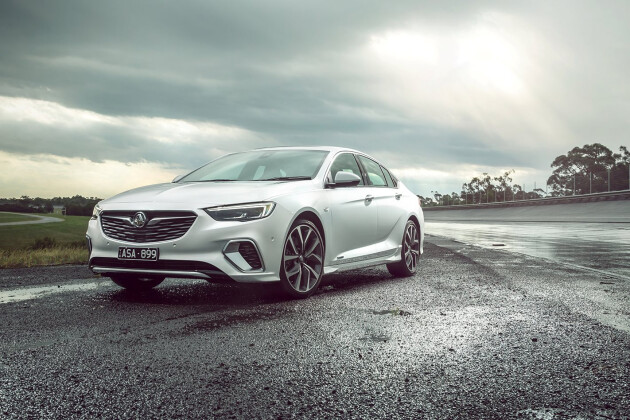 Advice
AdviceWhat now for Holden Commodore and Astra buyers and owners?
The Commodore and Astra were already discontinued, so what does Holden's closure mean for owners and buyers?
-
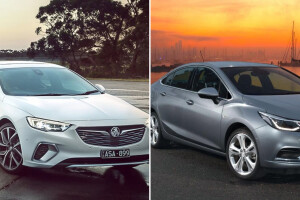 News
NewsOpel will still supply Holden, confirms PSA
PSA officials confirm that Holden deal to buy Commodore and Astra will continue
-
.jpg) Advice
AdviceWhichCar should I buy - should we avoid small brands?
A young couple thinks they can get a new car bargain by shopping the smaller brands. Are they right?
-
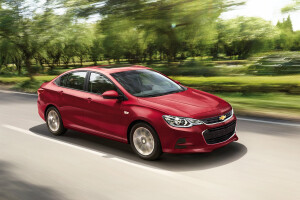 News
NewsChevrolet Cavalier revival could replace Holden Astra
Expanding its reach outside of China and Mexico, GM’s Cavalier small car could replace the endangered Astra
-

Holden dealers told import plans are “scuttlebutt” – report
-
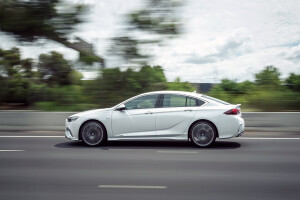
Holden, GM still silent about Inchcape import deal
-
.jpg)
Holden brings back seven-year warranty for Commodore and Equinox
-
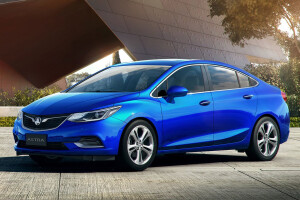
GM to shut down Holden Astra sedan factory


.jpg)

